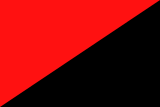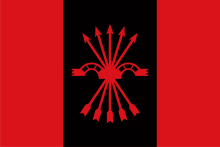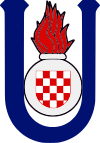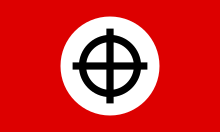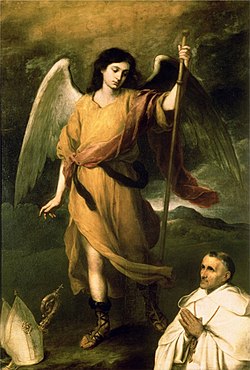From Wikipedia, the free encyclopedia
Hebrew mal’akh (מַלְאָךְ) is the standard word for "messenger", both human and divine, in the Tanakh (Hebrew Bible), though it is rarely used for human messengers in Modern Hebrew as the latter is usually denoted by the term shaliyah (שליח). The noun derives from the verbal consonantal root l-’-k (ל-א-ך), meaning specifically "to send with a message" and with time was substituted with more applicable sh-l-h. In Biblical Hebrew this root is attested only in this noun and in the noun "Mel’akah" (מְלָאכָה), meaning "work", "occupation" or "craftsmanship".
The morphological structure of the word mal’akh suggests that it is the maqtal form of the root denoting the tool or the means of performing it. The term Mal'akh therefore simply means the one who is sent, often translated as "messenger" when applied to humans; for instance, Mal’akh is the root of the name of the prophet Malachi, whose name means "my messenger". In modern Hebrew, mal’akh is the general word for "angel"; it is also related to the words for "angel" in Arabic (malak ملاك), Aramaic and Ethiopic.
In the Tanakh (Hebrew Bible)
The Tanakh reports that angels appeared to each of the Patriarchs, to Moses, Joshua, and numerous other figures. They appear to Hagar in Genesis 16:9, to Lot in Genesis 19:1, and to Abraham in Genesis 22:11, they ascend and descend Jacob's Ladder in Genesis 28:12 and appear to Jacob again in Genesis 31:11–13. God promises to send one to Moses in Exodus 33:2, and sends one to stand in the way of Balaam in Numbers 22:31.
Isaiah speaks of מַלְאַךְ פָּנָיו mal’ak panav, "the angel of the presence" ("In all their affliction He was afflicted, and the angel of His presence saved them: in His love and in His pity He redeemed them; and He bore them, and carried them all the days of old") (Isaiah 63:9).
The Book of Psalms says "For His angels will charge for you, to protect you in all your ways" (Psalms 91:11).
The angel of the LORD and the origins of angels
The figure of "the angel of the LORD" (Heb. מלאך יהוה; mal’akh YHVH)
has been perceived by generations of exegetes and interpreters as
obscure and perplexing. Almost every appearance of this figure in the Tanakh complies to the following pattern:
- The narration introduces the angel of the LORD;
- He behaves as if he were a deity, e.g. promising fertility (Genesis
21:18), annihilating an army with a single blow (e.g. 2 Kings 19:32-36),
or merely delivering a speech in which the angel presents himself as
God (e.g. Exodus 3:2-4);
- The interlocutors of this figure address and revere him in a way reserved exclusively to a deity.
As such, the incident leaves the reader with the question whether it was an angel or a deity who had just appeared.
There is a wide array of explanations striving to elucidate this
confusion. The most widespread theological ones try to deal with the
problem by introducing additional concepts: the angel might be an
earthly manifestation of God, some kind of avatar of God himself.
Another answer derives from cultural studies which argue that the
ancient commissioners during their proclamations used the first person
point of view and spoke as if they had been the consigner himself.
Angels and healing from impurity
There
are instances in the Bible where angels have the ability to heal an
individual from impurity. For example, in the book of Isaiah, Isaiah
sees angels praising the Lord. Their voices were so powerful that they
make the pivots on the thresholds shake and filled the temple with
smoke. (Isaiah 6: 3-4) All of this power made Isaiah feel unworthy and
unclean so he cried out, "Woe is me! I am lost, for I am a man of
unclean lips, and I live among a people of unclean lips; yet my eyes
have seen the King, the LORD
of hosts!" (Isaiah 6:5) Then one of the angels flew to Isaiah and
touched his mouth with a live coal that “had been taken from the altar
with a pair of tongs.” Once the angel had touched Isaiah's lips with the
coal, he then said, “Now that this has touched your lips, your guilt
has departed and your sin is blotted out.” (Isaiah 6: 6-7)
In the Book of Zechariah, Joshua was standing before the angel of
the Lord, and God. (Zechariah 3:3) He was “dressed in filthy clothes”
when standing before them. The angel then commanded him to take off his
filthy clothing and gave him “festal apparel” and a clean turban to put
on. At the removal of Joshua's filthy clothing, the angel proclaimed,
“See, I have taken your guilt away from you.” (Zechariah 3: 4-5) Thus,
the removal of Joshua's filthy clothing was like healing him from his
guilt.
Angels and prayer
In the Book of Zechariah, Zechariah hears from the Lord that He had been angry with his ancestors due to their evil deeds.
He promised them that if they “return[ed] to [Him], [He] would return
to [them].” Then the angel of the Lord prayed to the Lord and said, “O
Lord of hosts, how long will you withhold mercy from Jerusalem and the
cities of Judah, with which you have been angry these seventy years?”
Thus, the angel of the Lord prayed to God in order to petition for the
people (Zechariah 1:12).
Angels as warriors
In
the Bible there are some references to angels acting as warriors, the
protectors of all that is good. One of these references is The Book of
Daniel which contains four apocalyptic visions. However, in Daniel
10:13, it makes reference to a sort of battle between the prince of the
kingdom of Persia and the speaker whom is believed to be Gabriel. Here
Gabriel tells Daniel that the chief of princes, Michael, helped him in
the opposition he was facing from the prince of the kingdom of Persia.
Thus, both angels are acting as warriors for the good against the bad
opposition from the prince of the kingdom of Persia. In addition, in
Daniel 12:1, the speaker, Gabriel says that the angel Michael is the
protector of the Israelite people and is a great prince.
Angels as messengers
In
many passages from the Tanakh, angels are utilized as messengers;
indeed, there is no specific Hebrew equivalent for the English word
“angel”. Angels seem to have the appearance of ordinary humans; they are
typically men and (unlike seraphim),
have no wings. The presence of an angelic messenger versus a human
messenger must be determined by the context of the passage.
Regardless, messenger angels are a highly important part of
preserving and strengthening the link, as well as necessary distance, of
God to humans. The nature of the knowledge that angelic messengers
carry is always heavenly; that is to say, it is divine, and only by
being sanctioned by God can it be transmitted to humans, and only for
necessary reasons. When an angel transmits knowledge from God, his own
identity is effaced by that of his Lord; that is, he speaks directly for
God.
Examples of this role can be seen in numerous famous passages
from the Old Testament, including the three mysterious men in the story
of Abraham and the destruction of Sodom in Genesis 18:1-19:23, as well
as the angel who informs Samson's mother of the nature of the baby she
carries in Judges 13:3-5. In these examples, the angels are disguised,
their identities unimportant in relation to the heavenly magnitude of
the knowledge they possess; they are entirely defined by their jobs.
Angels as teachers in Jewish apocalyptic literature
Angels in the roles of teachers become especially important in Jewish apocalyptic literature, in such books as Daniel, Zechariah, and 4 Ezra,
which feature enigmatic and terrifying prophetic visions experienced by
unknowing humans who need heavenly guidance to understand what they
have witnessed; no longer does prophecy come with full or immediate
understanding.
Rather, a type of commentary or explanation of the vision is provided
through the figure of an interpreting angel, whose teachings dispel the
ignorance of the prophet and allow him to better understand, and thus
better propagate, the knowledge of the end times that his vision
contains.
Such knowledge of the apocalypse had both heavenly and earthly
implications, and assumed a great deal of importance to the oppressed
people of Israel at the time, who needed explanations for why God would
let them go through so much hardship; thus, the knowledge was “good.”
Because of the bizarre features of the visions contained in such
apocalyptic literature, interpreting angels assume the roles of teachers
rather than just messengers; instead of just conveying information,
they must explain it.
As teachers, they convey the full might and authority of heaven,
while being able to comfort their distressed human charges in a more
relatable way than if the prophets were directly spoken to by God. Thus,
angels as teachers function as relatable interpreters and testaments to
God's power, while also increasing His transcendence.
Most of all, they were important in establishing human prophets in
their proper role as comforters, with “good” knowledge, to the people of
Israel.
In 4 Ezra, the interpreting or teaching angel is Uriel.
When Ezra expresses his distress about issues that would be similarly
preoccupying Jews of his time—namely, why God would allow His chosen
people to suffer under the oppression of the Gentiles—Uriel is sent from
heaven by God to help relieve his ignorance. In the passage, Ezra
argues with Uriel about matters of justice in a way that he never could
with God; however, the angel argues back with a series of riddles that
eventually show Ezra the misguidedness of his thinking (4 Ezra
3:1-4:21). Importantly, Uriel does not simply transmit information or
“speak at” Ezra; the two are engaged in an animated dialogue that
reflects that of a teacher and a student, with the former guiding the
latter to a realization.
Ezra could never argue with God the way he argues with Uriel; however,
this argument and its accompanying emotional catharsis is partially what
leads him to discover the truth and main message of the passage on his
own.
In Daniel, angels also assume the roles of interpreters and
teachers, notably in their abilities to explain visions concerning the
eschaton, and help human prophets unknot knowledge from it. In Daniel,
it is the archangel Gabriel who is sent down from heaven by God to
explain Daniel's perplexing visions and help relieve some of his
distress (Daniel 8:16-17). In Daniel 7-12, the good knowledge that is
transmitted to Daniel and thus to the rest of the population, is that
the earthly events that have been so oppressing the Jewish people are
being mirrored in heaven, and that justice will eventually reign in the
form of a final battle pitting the armies of heaven against evil forces,
which will be vanquished.
However, Daniel is only aware of this information due to the
assistance of Gabriel, who teaches him the correct interpretation of his
vision, and encouraging him when he falters (Daniel 8:15-27). This role
of angels is mirrored in Zechariah, where angelic interpretation and
teaching is necessary to unravel the bizarre visions that the prophet
witnesses. In the passage, the angel literally walks through Zechariah's
visions with him, explaining and teaching him as they go along so that
Zechariah properly understands God's intended meaning (Zechariah
1:9-5:11).
In rabbinic literature
As a subcategory of heavenly beings, mal’akim occupy the sixth rank of ten in Maimonides' Jewish angelic hierarchy.
Michael, Gabriel, Uriel, and Raphael
The Talmud names four angels who would later be known as archangels, surrounding God's throne:
As the Holy One blessed be He
created four winds (directions) and four banners (for Israel's army), so
also did He make four angels to surround His Throne—Michael, Gabriel,
Uriel and Raphael. Michael is on its right, corresponding to the tribe
of Reuben; Uriel on its left, corresponding to the tribe of Dan, which
was located in the north; Gabriel in front, corresponding to the tribe
of Judah as well as Moses and Aaron who were in the east; and Raphael in
the rear, corresponding to the tribe of Ephraim which was in the west.




